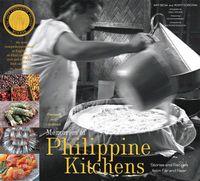Advertisement
Food That Was Borrowed and Made Our Own

Appears in
By Amy Besa and Romy Dorotan
Published 2006

Making pancit in Malabon.
While Filipinos worked and tilled the soil, the main plot of the colonial political drama was propelled by the love-hate relationship between the Spanish and the Chinese. Eventually the Filipinos rebelled and cast off the oppressive yoke of the Spanish masters.
The processes by which China and Spain flavored Filipino cooking were vastly different. The Chinese came to the Philippines as traders, looking for wealth and new opportunities, settling as merchants in every town and village, starting from the bottom of the social ladder and working their way up. They had access to goods from China, and when they accumulated enough capital they were able to assimilate into every social stratum and economic class of the Philippines. There was no class status attached to the Chinese food available at the restaurants, called panciterias, of Chinatown. Everyone, including the Spanish elite who were the targeted clientele of the panciterias, ate Chinese food.

